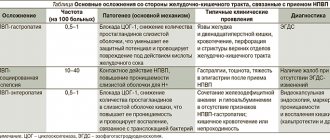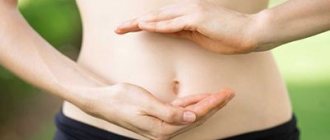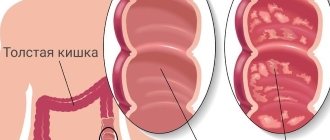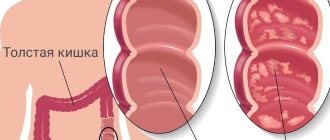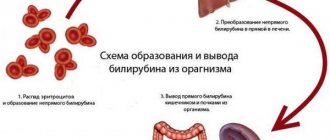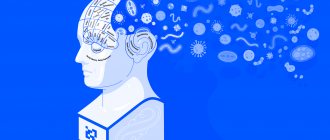MAKING AN APPOINTMENT WITH A DOCTOR IN ST. PETERSBURG
+7 or +7
Ulcerative colitis, or nonspecific ulcerative colitis (UC)
IBD is a chronic autoimmune inflammatory bowel disease (IBD) that causes ulcers in the human digestive tract. Ulcerative colitis affects the intestinal mucosa, its deepest layers, which leads to blood loss, dehydration, loss of iron, magnesium, potassium, calcium, and exhaustion of the body. Ulcerative colitis usually develops in people under 30 years of age, equally in both sexes.
One of the reasons for the appearance of ulcerative colitis is a malfunction of the immune system, when it gives an abnormal response to attempts to invade the infection. As a result of this abnormal response, cells in the digestive tract are affected, leading to lesions of ulcerative colitis. The autoimmune process in ulcerative colitis also causes arthritis, conjunctivitis, chronic hepatitis, and erythema nodosum.
Ulcerative colitis can cause life-threatening complications such as:
- toxic megacolon,
- colon perforation,
- colorectal cancer
, - bleeding or thrombosis;
- pyoderma gangrenosum.
Clinical symptoms of ulcerative colitis
At the initial appointment, the gastroenterologist conducts a survey of the patient, clarifying the presence of clinical symptoms typical for ulcerative colitis. Adult patients may present with one or more symptoms that are highly likely to indicate ulcerative colitis, including:
- recurrent diarrhea, which cannot be cured by conventional remedies;
- rectal pain and rectal bleeding (bloody stools);
- abdominal pain and cramps (mainly before bowel movements);
- tenesmus (false urge to defecate);
- nocturnal stools awakening from sleep;
- urgency (fecal incontinence);
- fever of unknown etiology, weight loss, general weakness;
- joint pain and other extraintestinal symptoms (skin lesions in the form of red, bumpy, painful rashes, inflammation of the eyes, discomfort and pain in the lumbar region, etc.).
In young patients, parents should suspect something is wrong if the child is not eating well, is not active enough, is losing weight, and is stunted. Children's stool is also unformed.
Types of Ulcerative Colitis
Montreal classification according to the extent of the lesion:
- Proctitis
, in which the source of inflammation is located in the rectum, closer to the anus. In this case, the only symptom that may indicate the disease is rectal bleeding. - Left-sided colitis
, including
proctosigmoiditis
. In this form of ulcerative colitis, inflammation extends from the rectum up to the left (splenic) flexure of the colon, affecting the sigmoid colon and often the descending colon. Symptoms of left-sided colitis include bloody diarrhea, abdominal cramps and pain on the left side, and a urge to defecate (tenesmus) that does not lead to a bowel movement. - Total colitis
, or
pancolitis
. It is characterized by inflammation of the entire colon. Signs of pancolitis include frequent bouts of bloody diarrhea, cramping abdominal pain, anemia due to bleeding, and significant weight loss.
Prevention
The main method of preventing any problems with the gastrointestinal tract is the habit of a healthy lifestyle. Knowing about the hereditary predisposition to ulcerative colitis, it is necessary to eat properly, avoiding foods that irritate the intestines. You should completely give up alcohol and cigarettes, monitor your weight, normalize your work and rest schedule, play sports, and avoid stress and emotional stress.
It is necessary to carefully monitor the condition of the body, do not ignore any gastrointestinal ailments and undergo regular examinations.
The nature of the course of ulcerative colitis
- Acute course
(less than 6 months from the onset of the disease):- a disease with a fulminant (sudden and rapidly developing) onset;
- a disease that develops gradually.
- Chronic continuous course
(absence of more than 6-month periods of remission against the background of adequate therapy). - Chronic relapsing course
(presence of more than 6-month periods of remission):- rarely recurrent (once a year or less);
- often recurrent (2 or more times a year).
Literature
- Adler DJ, Korelitz BI. The therapeutic e.cacy of 6-mercaptopurine in refractory ulcerative colitis. Am J Gastroenterol 1990;85:717-22.
- Ardizzone S, Molteni P, Imbesi V, Bollani S, Bianchi Porro G, Molteni F. Azathioprine in steroid-resistant and steroid-dependent ulcerative colitis. J Clin Gastroenterol 1997; 25:330-3.
- Bianchi Porro G, Prantera C, Campieri M, Petrillo M, Campanini MC, Gionchetti P et al. Comparative trial of methylprednisolone and budesonide enemas in active distal ulcerative colitis Eur J Gastroenterol Hepatol 1994;6:125-30.).
- Faubion WA Jr, Loftus EV Jr, Harmsen WS, et al.: The natural history of corticosteroid therapy for inflammatory bowel disease: a population-based study. Gastroenterology 2001, 121: 255-260.
- Gionchetti P, Rizzello F, Venturi A, et al. Comparison of oral with rectal mesalazine in the treatment of ulcerative proctitis. Dis Colon Rectum 1998;41:93-7.
- Green JRB, Lobo AJ, Holdsworth CD, et al. Balsalazide is more effective and better tolerated than mesalamine in the treatment of acute ulcerative colitis. Gastroenterology. 1998; 114:15-22.
- Guslandi M, Frego R, Viale E, Testoni PA: Distal ulcerative colitis refractory to rectal mesalamine: role of transdermal nicotine versus oral mesalamine. Can J Gastroenterol 2002, 16:293-296.
- Limann M, Galian A, Rutgeerts P, van Heuverzwijn R, Cortot A, Viteau JM et al. Comparison of budesonide and 5-aminosalicylic acid enemas in active distal ulcerative colitis. Aliment Pharmacol Ther 1995; 9: 557-62.
- Lichtiger S, Present DH. Preliminary report: Cyclosporin in treatment of severe active ulcerative colitis. Lancet 1990;336:16-9.
- Lichtiger S, Present DH, Kornbluth A, et al. Cyclosporine in severe ulcerative colitis refractory to steroid therapy. N Engl J Med 1994;330:1841-5.
- Marshall JK, Irvine EJ. Rectal corticosteroids versus alternative treatments in ulcerativecolitis: A meta-analysis. Gut 1997;40:775-81.
- Mulder CJ, Fockens P, Meijer JW, et al. Beclomethasone dipropionate (3 mg) versus 5-aminosalicylic acid (2 g) versus the combination of both (3 mg/2 g) as retention enemas in active ulcerative proctitis. Eur J Gastroenterol Hepatol 1996;8:549-53.).
- Odes HS, Fich A, Reif S, et al.: Effects of current cigarette smoking on the clinical course of Crohn's disease and ulcerative colitis. Dig Dis Sci 2001, 46: 1717-1721.
- Panes J, Esteve M, Cabre E, et al.: Comparison of heparin and steroids in the treatment of moderate and severe ulcerative colitis. Gastroenterology 2000, 119: 903-908.
- Pruitt R, Hanson J, Safdi M, et al. Balsalazide is superior to mesalamine in the time to improvement of signs and symptoms of acute ulcerative colitis. Gastroenterology. 2000; 118(Suppl 2 Part 1): A120-1.
- Rufle W, Fruhmorgen P, Huber W, Kimmig JM: Budesonide foam as a new therapeutic principle in distal ulcerative colitis in comparison with mesalazine enema: an open, controlled, randomized and prospective multicenter pilot study. Z Gastroenterol 2000, 38:287-293.
- Safdi M, DeMicco M, Sninsky C, et al. A double-blind comparison of oral versus rectalmesalamine versus combination therapy in the treatment of distal ulcerative colitis. Am J Gastroenterol 1997;92:1867-71.
- Sandborn W, Tremaine W, Leighton J, et al. Nicotine tartrate liquid enemas for mildly to moderately active left-sided ulcerative colitis unresponsive to .rst-line therapy: A pilot study. Aliment Pharmacol Ther 1997;11:661-71.
- Sutherland L, MacDonald JK Oral 5-aminosalicylic acid for induction of remission in ulcerative colitis. Cochrane Database Syst Rev (England), 2003, (3) pCD000543.
- Vrij AA, Jansen JM, Schoon EJ, et al.: Low molecular weight heparin treatment in steroid refractory ulcerative colitis: clinical outcome and influence on mucosal capillary thrombi. Scand J Gastroenterol 2001, 234(Suppl): 41-47.
Screening and diagnosis of ulcerative colitis
stool test for calprotectin is used as a screening
. With fecal calprotein (FC) values below 50 mcg/g, the probability of having an active inflammatory disease in the intestine (ulcerative colitis or Crohn's disease) is less than 1%, and with a value above 150 mcg/g, it makes sense to carry out a differential diagnosis of ulcerative colitis.
There are no clear diagnostic criteria for ulcerative colitis. The diagnosis is made on the basis of anamnesis, clinical picture, laboratory results, endoscopic and histological changes in the intestine.
Stool tests
- General analysis of stool (coprogram)
. The doctor will prescribe a coprogram to assess the functional capacity of the gastrointestinal tract. In addition, a large number of leukocytes in the stool indicates an inflammatory process in the intestines, caused, as an option, by ulcerative colitis. A stool test from a patient with ulcerative colitis usually shows blood, pus, and mucus. - Fecal calprotectin (FC)
. During the initial diagnosis and/or to assess the activity of the inflammatory process, a study of the FC level is required. FC is also a reliable marker for assessing the effectiveness of UC treatment. - Fecal occult blood test (Gregersen test)
. Examination of feces for occult blood allows one to suspect the earliest stages of ulcerative processes. The analysis makes it possible to detect altered hemoglobin in erythrocytes even if the erythrocytes themselves are not detected during microscopic examination of stool. - Fecal tests for helminth eggs
. A standard stool test for worm eggs will help rule out enteritis and colitis of a parasitic nature, or at least avoid complications. - Smear for pathogenic microflora
. During bacteriological tests, the presence of Shigella, Salmonella, Yersinia, Campylobacter, and tubercle bacilli is determined. Pathogenic microflora is often sown in the stool of patients with ulcerative colitis. - Stool analysis for amebodiasis (optional).
According to WHO, about 10% of people on Earth are carriers of dysentery amoebas, mainly residents of countries with hot climates (Mexico, India, etc.). Dysenteric amoebas can cause prolonged diarrhea with pathological impurities in the stool, abdominal pain, dehydration, which can ultimately lead to death. Tell your doctor if you have returned from southern countries. - Determination of toxins A and B (optional)
. Patients who have undergone a course of antibiotics and/or hospital treatment are prescribed a stool test for clostridial toxins. The analysis will exclude/identify pseudomembranous colitis caused by this hospital infection, which can negate all treatment.
Blood tests
- General blood analysis
. The analysis is necessary for the doctor to evaluate the metabolic disorders that often accompany ulcerative colitis (anemia, hypoproteinemia, electrolyte imbalance), systemic disorders (changes in blood composition and coagulation). A low number of red blood cells and hemoglobin will indicate anemia, an increased level of platelets (>350*109/l) will indicate activation and progression of the disease, the risk of thrombolic complications, and an increased level of leukocytes will indicate chronic inflammation and poisoning of the body with endotoxins. It is assumed that endotoxemia is involved in the pathogenesis of ulcerative colitis, Crohn's disease, and colorectal cancer. - Erythrocyte sedimentation rate (ESR)
. An increase in ESR is an indirect sign of current inflammation. For example, with a moderate form of ulcerative colitis, the ESR reaches 30 mm/h. In severe cases, this figure is even higher. With increasing endoscopic activity of the disease and the extent of the lesion, the ESR also increases. - C-reactive protein (CRP)
. Protein of the acute phase of inflammation naturally increases in inflammatory bowel diseases. A slight increase or normal levels are characteristic of nonspecific ulcerative colitis, high levels are characteristic of Crohn’s disease with similar symptoms. Due to the property of CRP to rapidly decrease during remission, the study allows us to evaluate the effectiveness of treatment. - Biochemical blood test: ALT and AST, total bilirubin, total protein, glucose, total cholesterol, creatinine, urea, electrolytes
.
Additionally, the doctor may prescribe biochemical blood tests for albumin
(for severe diarrhea),
iron
(for anemia). A biochemical blood test is included in the “clinical minimum”, allowing one to assess the involvement of other organs (liver, kidneys) in the pathological process. A decrease in the level of total protein, glucose, cholesterol, and electrolytes (potassium, magnesium, calcium) helps determine malabsorption in the intestine. In addition, the results of the analysis for total protein will show a decrease in the concentration of albumin (less than <35 g/l) and an increase in the concentration of gammaglobulins, which is associated with the active production of antibodies. - Hemocoagulogram
. The presence of chronic inflammation and increased bleeding of the intestinal wall in ulcerative colitis initiates activation of the coagulation system, impairs the process of dissolution of blood clots and blood clots, and also reduces the activity of natural anticoagulation mechanisms. In turn, hypercoagulability may support the activation of the inflammatory response. The results of a coagulogram can identify various disorders in the blood coagulation system and break the vicious circle between chronic inflammation and thrombosis, as well as reduce the risk of bleeding and blood clots. - Immunological blood test pANCA and ASCA (optional)
. Detection of antibodies to the cytoplasm of neutrophils and to Saccharomyces (they appear due to an abnormal immune response) can be useful in the differential diagnosis of UC with Crohn's disease. p-ANCA are present more often in ulcerative colitis, and ASCA are more often present in Crohn's disease. Under the influence of antibodies, neutrophils are destroyed, which promotes inflammatory reactions, and as we remember, ulcerative colitis has a specific autoimmune nature of the disease. But not all people with Crohn's disease or ulcerative colitis have elevated levels of these antibodies.
Urine tests
A general urine test is necessary to assess the involvement of other organs in the pathological process. Ulcerative colitis is caused by immune disorders, and these same disorders can cause kidney damage and the formation of kidney stones.
Endoscopic studies
When diagnosing IBD, the following types of endoscopy may be prescribed:
- Colonoscopy
is an endoscopic examination of the entire colon (1.5 meters) using a flexible long endoscope. - Sigmoidoscopy
is a more gentle endoscopic examination of the rectum and lower parts of the large intestine (sigmoid colon). A sigmoidoscope is a short colonoscope (50-60 cm). - Rectoscopy
is an endoscopic examination of the rectum and the distal third of the sigmoid colon to a level of 20-35 cm from the anus using a tube rectoscope. - Gastroscopy
is an endoscopic examination of the stomach and duodenum.
rectoscopy is performed first.
with multiple biopsies. The procedure is gentle and does not require special preparation. The doctor inserts a rigid tube, usually no more than 35 cm long, into the rectum and assesses the condition of the intestinal mucosa, vascular network, the presence of ulcers, erosions and narrowing of the lumen. Modern sigmoidoscopes can be equipped with a fiber-optic video system and a device for taking biopsies and removing tumors. Colonileoscopy (total colonoscopy with examination of the sigmoid colon) is postponed until the condition has stabilized.
The most informative method of endoscopic examination, as you may have guessed, in patients with intestinal problems is colonileoscopy
.
With this method, the rectum, colon and ileum are examined using a thin flexible tube. A camera with an LED is installed at the end of the probe, and a fiber-optic cable is built into the tube itself, through which the image is transmitted to the doctor’s computer. The study is carried out in real time under anesthesia. Colonoscopy is contraindicated for patients with active inflammation and acute intestinal complications
, therefore, despite the high information content of the method, it is not always prescribed (mainly when the issue of surgical treatment of ulcerative colitis with removal of the colon is being decided).
If there are symptoms from the upper gastrointestinal tract and doubts about the diagnosis, the doctor may prescribe gastroscopy with biopsy
.
Histological studies
In case of initial diagnosis, doubts about the correctness of a previously made diagnosis, or with a long history (to exclude dysplasia and colorectal cancer), a biopsy of tissue from the mucous membrane of the rectum, colon and/or ileum is taken during an endoscopic examination and sent for histology. Histological examination of a biopsy (a piece of intestinal mucosa taken during an endoscopic examination) usually allows one to finally determine the diagnosis.
Radiography
X-ray examinations of the colon are carried out when endoscopic examination is impossible or insufficiently informative (for strictures, deformities of the colon). There are also two types of X-ray studies:
- X-ray of the large intestine with contrast.
As an alternative, your gastroenterologist will primarily suggest this option, also known as
double-contrast barium enema
. On the eve of the study, the patient takes a laxative and undergoes cleansing enemas. Immediately before the test, the patient will receive an enema with a contrast agent containing barium. The solution settles on the walls, which makes it possible to examine the relief of the mucosa. After a bowel movement, air is injected into the bowel to inflate it, and x-rays are taken again. The resulting images can reveal areas of inflamed and ulcerated colon mucosa, as well as narrowing and dilation. - Plain radiography of the abdominal cavity.
In case of a severe attack, to exclude toxic dilatation (megacolon) and perforation of the colon, the doctor may prescribe a plain radiography of the abdominal cavity. No special preparation is required. - X-ray of the chest organs.
When deciding whether to prescribe biological therapy. Alternatively, the doctor may prescribe the Mantoux test, Diaskin test or Quantiferon test.
Ultrasound examinations
If everything is so bad that the injection of contrast is contraindicated for the patient, in the arsenal of modern doctors there is a transabdominal ultrasound of the intestine, ultrasound of the abdominal organs, ultrasound of the retroperitoneal space, ultrasound of the pelvis
. You don’t even need indications to undergo an ultrasound: it is advisable for everyone to undergo it as a screening test. Ultrasound has low specificity in differentiating ulcerative colitis from colitis of other origins (and therefore is not a first-line study), but the inflammatory process in the intestine will show.
In everyday practice, simple criteria will help the doctor determine the severity of the disease with a confirmed diagnosis (mild, moderate or severe): frequency and consistency of stool during the last exacerbation, temperature, pulse, blood test results, the presence of extraintestinal manifestations and complications, the presence of hormonal dependence or resistance to medications.
In order to clarify the diagnosis and select therapy for extraintestinal manifestations of UC and concomitant diseases, consultation with the following specialists may be required:
- endocrinologist
(steroid diabetes mellitus, adrenal insufficiency with long-term hormonal therapy); - dermatologist
(differential diagnosis of erythema nodosum, pyoderma); - rheumatologist
(arthropathy, sacroiliitis); - surgeon
(toxic dilatation of the colon; severe attack or bleeding that does not respond to conservative therapy, continuous course of the disease); - oncologist
(dysplasia of the intestinal mucosa).
Causes
Despite the long history of studying the causes of the disease, they are still not fully understood, and determining the etiology of ulcerative colitis is considered one of the most difficult problems of gastroenterology. There are several theories of the pathogenesis of the disease, which are based on factors of different nature:
- Genetic. As a result of long-term clinical studies, it was found that people who have one of their parents also suffered from this disease are more likely to suffer from ulcerative colitis. The genetic theory is based on the assumption that certain genes are mutated.
- Infectious. The inflammatory process in the large intestine can be caused by certain types of pathogenic microflora. In addition, ulcerative colitis may result from an excessive immune reaction to antigens of certain non-pathogenic bacteria present in the intestines.
- Autoimmune. According to some researchers, the cause of ulcerative colitis is the destruction of epithelial cells of the large intestine as a result of the formation of antibodies against self-antigens.
Predisposing factors for the occurrence of ulcerative colitis:
- unhealthy diet with excess animal protein and lack of dietary fiber;
- nervous tension;
- various viral infections;
- lack of vitamin D in the body;
- sedentary lifestyle, smoking, alcohol abuse.
Food allergies, for example, intolerance to nuts, milk, honey and other products, can also play a role in the occurrence of pathology.
Treatment of ulcerative colitis
Conservative therapy (drugs)
A cure for ulcerative colitis has not yet been invented, but doctors have successfully put this disease into remission with anti-inflammatory drugs 5-aminosalicylic acid: sulfasalazine or mesalazine. Sometimes - in combination with hormonal drugs: prednisolone, dexamethasone. Hormones are used to treat ulcerative colitis when 5-ASA drugs are not effective enough or when the attack is severe. It should be noted that in severe attacks of ulcerative colitis, the patient should be treated in a hospital. Microenemas, rectal suppositories, antibiotics, etc. can also be used in the treatment of ulcerative colitis.
Hormonal drugs do not heal the colon mucosa, but only reduce the activity of exacerbation of ulcerative colitis. The goal of conservative therapy in the treatment of UC is the emergence of stable remission with cessation of glucocorticoids. The non-operated patient must constantly take maintenance therapy to avoid relapse.
Surgery
Complete cure of ulcerative colitis is possible by removing the substrate of the disease (colproctectomy). Despite the effectiveness of drug therapy, surgery will still be needed sooner or later, and it is better not to delay it. Surgery will be required if the patient has hormonal dependence or resistance to treatment. Up to 80% of these conditions can be overcome with drugs that suppress the immune system.
Intestinal complications that require emergency surgery in any case include: intestinal bleeding, deep ulcerations, toxic megacolon, colon perforation, colorectal cancer or a high risk of its occurrence.
Examples of exercises to improve bowel function
The choice of intensity and level of load depends on the current state. Based on the results of completing a set of exercises, a person with IBD should not feel increased fatigue and loss of strength (instead, there should be a feeling of vigor).
An approximate set of exercises (to perform it you will need a gymnastic meter stick or any other 60-centimeter length):
- Sit on a chair, straighten your back. On the count of “one”, raise your arms up, on “two” - take the starting position. Do 5-10 approaches.
- While sitting on a chair, place your nails shoulder-width apart (make sure your back remains straight). Using both hands, bring the stick closer to your chest and then return to the starting position. Perform the exercise 5-10 times.
- Without changing your position, alternately lower the stick to your right and left knees. Requires 5-7 repetitions.
- In a sitting position, connect and extend your legs: “one” - the stick is at the top, “two” - the right leg rises, “three” - the stick touches the raised shin. The exercise is applied to both legs. The number of repetitions is 10 times.
- Lying on your back, straighten your legs and extend your arms to the sides. Lift each leg up one at a time. 5-6 approaches.
- Stand up straight, move your heels together, toes apart. The stick is in front of you (rest your hands on the upper end). “One” - the left leg is at the top, “two” - in the starting position. “Three” - right leg at the top, four - in the original position. Repeat the exercise 5 times.
After a 10-minute exercise therapy session, the pulse should not exceed 100 beats per minute. You should not perform more than 25 breathing exercises in 60 seconds.
It is best to do therapeutic exercises in the fresh air, and if this is not possible, dress correctly (things should not hinder movement; it is better to choose cotton material).
It is better to start exercising in the morning after a light breakfast. Sports are not beneficial on an empty stomach; it is necessary to give the body the opportunity to prepare for the upcoming loads.
Bowel exercises for constipation
Prevention and treatment are carried out in two ways. Exercises for constipation:
- Lie on your back (it's better to do this on a bed or sofa). Lightly stroke the navel area in a clockwise direction for 2-3 minutes, and the same amount in the opposite direction. Then lift your left leg, bend it and press it to your chest for 1-2 minutes. Repeat the same with your right leg.
- Rise up and spread your feet shoulder-width apart, place your hands on your belt. Squat down, hold for 10-15 seconds and take deep breaths into your belly. The number of repetitions is from 10 to 15.
Perform these two simple bowel exercises for constipation every day in the morning, 20-30 minutes after breakfast.
Exercises for the intestines for flatulence
Helps against excessive gas formation in the stomach:
- Fetal position.
Sit on the floor with your knees bent and bend down, placing your body on your hips and stretch your arms forward above your head. You need to hold this position for no more than 30 seconds.
- Tilts.
Another useful exercise for flatulence: standing up straight, slightly spread your legs, and then pull them up to your stomach one by one. Each approach is performed for 30 seconds. Requires 5 repetitions.
- Wheel pose.
Lie comfortably on your stomach and clasp your legs at the feet. Make rocking movements back and forth. Do not use this exercise if discomfort or pain occurs.
Bowel exercises to prevent diarrhea
With the help of gymnastics, the functioning of the digestive tract is improved, the signs of diarrhea are reduced, and the production of gastric juice is normalized. Exercise is useful if there is a need for prevention.
- Exercise 1.
Lie on your back, close and extend your legs, lowering your arms along your torso. Bend your fingers and toes 6-8 times simultaneously. Watch your breathing, which should be even.
- Exercise 2.
Without changing your position, alternate inhalation and exhalation. Repeat at a slow pace (do 3 sets).
- Exercise 3.
Lying down, bend your elbows 4-6 times, then straighten them. The pace is average, breathing is relaxed.
- Exercise 4.
In the same position, spread your legs (shoulder-width apart), lower your arms along your body, spread your toes to the sides, then bring them together. Perform up to 6 repetitions.
- Exercise 5.
Lying on your back with your legs joined together, inhale and raise your shoulders; exhale, relax. Do 3 sets.
- Exercise 6.
Starting on all fours, straighten up and move to your knees, then return to the starting position. 2 to 4 approaches are expected.
- Exercise 7.
Lying on your back, lean on your elbows and bend your knees. Raise and lower your pelvis at a slow pace. Requires 2-4 repetitions.
